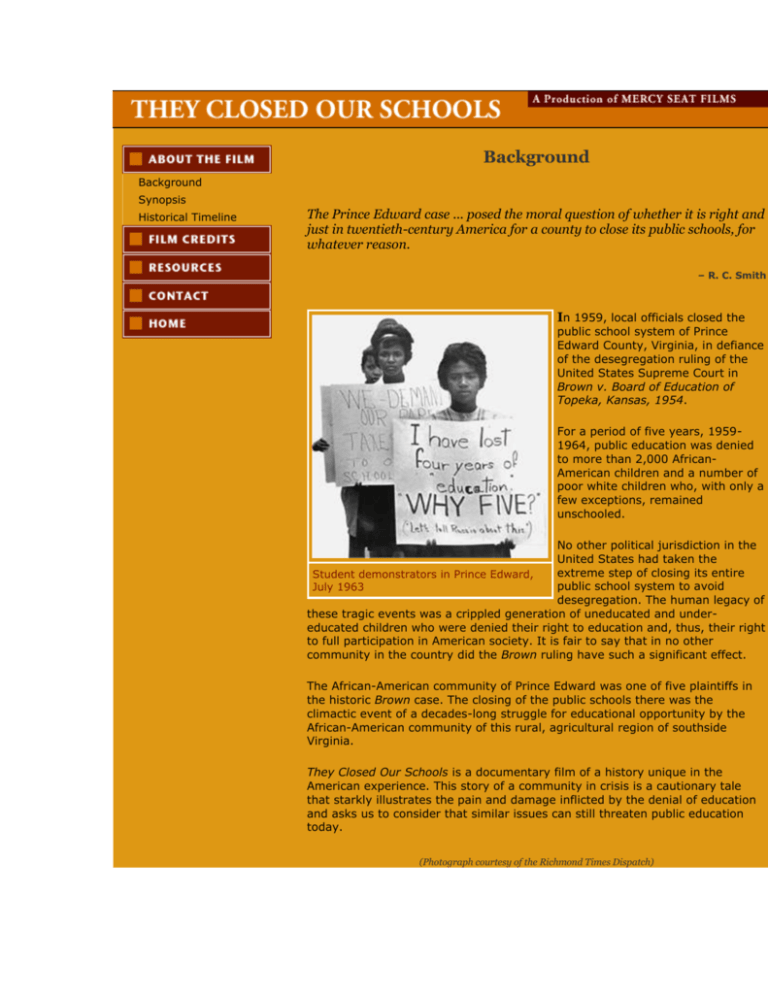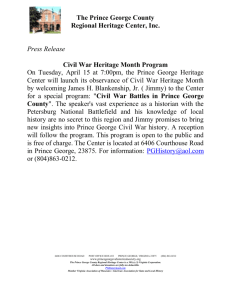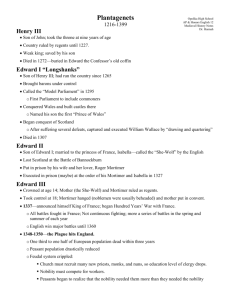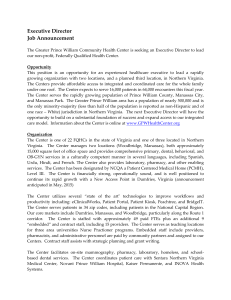Historical Timeline
advertisement

Background Background Synopsis Historical Timeline The Prince Edward case ... posed the moral question of whether it is right and just in twentieth-century America for a county to close its public schools, for whatever reason. – R. C. Smith In 1959, local officials closed the public school system of Prince Edward County, Virginia, in defiance of the desegregation ruling of the United States Supreme Court in Brown v. Board of Education of Topeka, Kansas, 1954. For a period of five years, 19591964, public education was denied to more than 2,000 AfricanAmerican children and a number of poor white children who, with only a few exceptions, remained unschooled. No other political jurisdiction in the United States had taken the extreme step of closing its entire Student demonstrators in Prince Edward, public school system to avoid July 1963 desegregation. The human legacy of these tragic events was a crippled generation of uneducated and undereducated children who were denied their right to education and, thus, their right to full participation in American society. It is fair to say that in no other community in the country did the Brown ruling have such a significant effect. The African-American community of Prince Edward was one of five plaintiffs in the historic Brown case. The closing of the public schools there was the climactic event of a decades-long struggle for educational opportunity by the African-American community of this rural, agricultural region of southside Virginia. They Closed Our Schools is a documentary film of a history unique in the American experience. This story of a community in crisis is a cautionary tale that starkly illustrates the pain and damage inflicted by the denial of education and asks us to consider that similar issues can still threaten public education today. (Photograph courtesy of the Richmond Times Dispatch) Synopsis Background Synopsis Historical Timeline School bus delivering students to tar-paper building at Robert R. Moton High School, 1953 ... if you're looking at it on a national scale, I'd say we won a victory. I believe you could say the black people of Prince Edward County saved the public schools of the South, particularly in Virginia. Had we given in, I think perhaps massive resistance might have become the order of the day throughout the South. So in that sense we won a tremendous victory. – The Reverend L. Francis Griffin On April 23, 1951, in an event that foreshadowed the coming Civil Rights Movement, Barbara Johns, a sixteen-year-old African-American high school junior at Moton High, and fellow student leaders, organized their classmates in a two-week boycott of their overcrowded and unsafe high school in Farmville, the county seat. The strike, which began as a demand for equality in separate educational facilities, became, at the urging of the NAACP, a vital part of the growing movement for integration in all public education. This documentary film is the largely untold story of how one girl’s courage helped set in motion the most important Supreme Court decision of the 20th century, Brown v. Board of Education, a decision that adjusted the path of the United States back into alignment with the principles on which it was founded. It is a story that is filled with unsung heroes, ordinary people whose faith in those same principles - liberty, justice, freedom, equality - drove them to reach beyond themselves to “preserve, protect, and defend the Constitution of the United States.” The student-inspired influence from Prince Edward County, Virginia, upon the legal battles that became Brown v. Board of Education, has been largely overlooked in the sweeping history of the Civil Rights movement. Yet the vision and courage of Barbara Johns and her fellow students, the moral and spiritual guidance of the Reverend L. Francis Griffin, and the commitment and purpose of this African-American community, deserve to be honored and remembered with the greatest moments in that history. Building upon archival documents, film footage, still photographs, and sound recordings, as well as personal papers and memorabilia, the historical framework for the film will reveal the struggle of the African-American community of Prince Edward for educational opportunity. Within this framework the film will present contemporary film footage, on-camera interviews, and the perspective of history through the words and voices of those who experienced it. They Closed Our Schools will examine the effects of the school crisis on the children of both the black and the white communities and the years of the “crippled generation” of undereducated and uneducated children. Of more than two thousand children affected by the public schools closing, it is estimated that less than five per cent received schooling for all five years and most received no education at all. Interviews conducted with individuals who, as children, experienced the numerous consequences of the school closing are central to the film. These will include individuals sent away from home for school, some of whom actually found greater opportunity; those educated through the valiant efforts of their churches and families; and those children denied any opportunity for literacy. The stories will include those of African-American men who served their country in WWII and the Korean Conflict, and then found education refused to their children at home; of a young boy sent to Iowa for school in the care of a Quaker family whose mother experienced similar deprivation as a JapaneseAmerican internee during WWII; of a Prince Edward student taken into the home of Holocaust survivors so that he could continue his education; and the story of a young girl who grew up to become a second grade teacher and now marvels at her role as she, herself, was denied the opportunity to attend second grade. The film will chronicle the history of public education in Prince Edward from its post Civil War origins in the Freedman Bureau schools, to the 1920s effort for secondary education, to the building of the first black high school in 1939; from the student school strike of 1951 against over-crowded, inadequate facilities, to the inclusion of the Prince Edward schools in the 1954 Brown Supreme Court case; from the rise of Massive Resistance against school desegregation to the closing of the public schools in 1959 and the political example of Prince Edward County which fueled the battle to sustain segregation across the South. The film will examine the long legal battles to reopen the public schools in 1964; and the decades-long struggle to reestablish and reinvigorate public education in the county. The attempt to end public education in Prince Edward County, provoked the 1964 ruling by the United States Supreme Court in Griffin v. County School Board of Prince Edward County that ordered the reopening of the public schools in Prince Edward and helped establish a fundamental right to public education in the United States. This history of Prince Edward County, while not well known, is a vital part of the Brown case and its historic legacy, and is deserving of national recognition. (Photograph by Hank Walker/Life Magazine courtesy of TimePix) Historical Timeline Background Synopsis Historical Timeline Virginia & the Nation Prince Edward County 1865 1865 April 9 – Lee surrenders to Grant at Appomattox Court House April 6 – Sailor's Creek, last battle of Virginia campaign in the Civil War April 7 – Lee, then Grant, passes through Farmville July – Freedmen's Bureau starts first school for blacks 1870 First public schools in Virginia 1870 First public schools in county open on segregated basis 1896 Plessy v. Ferguson Supreme Court Case approves legally enforced segregation, establishing concept of "separate but equal" 1897 W.E.B. DuBois visits Prince Edward County 1902 Virginia Constitutional Convention disenfranchises most black voters 1920s1930s Black community petitions for high school grades and better school facilities 1930s1940s NAACP legal battles for equalization in all aspects of education 1939 Robert R. Moton High School built with PWA funding, one of only ten black high schools in rural Virginia 1948 Tar paper buildings constructed at Moton High School to alleviate overcrowding 1950 Sweatt v. Painter Supreme Court case changes NAACP legal strategy from equalization to desegregation 1951 April 23 – Student strike at Moton High School May 21 – First Prince Edward school court case filed, Davis v. County School Board of Prince Edward County, Virgini 1954 1952 Three judge Federal panel rules agains plaintiffs in Davis case. Ruling appealed by NAACP to the Supreme Court 1953 New Moton High School built by county in effort for school facilities equalization to thwart school desegregation court case May 17 – Brown v. Board of Education 1954 Supreme Court case rules "separate but equal" unconstitutional June 25 – Governor Thomas Stanley states he will use all legal means to continue segregated school in Virginia 1955 May 31 – Brown II Supreme Court case orders desegregation of schools "with all deliberate speed" Oct – Defenders of State Sovereignty formed to preserve segregation in schools. 1955 June – Prince Edward School Foundation formed to develop private school education program 1956 More than 4,000 white citizens petition County asking not to be taxed to support integrated schools Dec 1 – Rosa Parks refuses to give up her seat on bus in Montgomery, Alabama 1956 Feb 25 – Senator Harry Byrd, Sr. calls for "massive resistance" to desegregation March 12 – Senator Harry Byrd and Congressman Howard Smith of Virginia introduce the "Southern Manifesto" in U.S. Congress as a resolution condemning Supreme Court encroachment on states' rights May 3 – Prince Edward Board of Supervisor states that it will not appropriate money for desegregated schools Sept – Massive Resistance legislation enacted in Virginia. State tuition grants created to support private segregation academy schools 1957 Sept – Central High School integrated, Little Rock, Arkansas 1958 Sept – Massive Resistance laws invoked; 12,000 children out of school in Norfolk, Charlottesville, and Front Royal, Virginia 1959 Jan – Courts strike down Virginia’s Massive Resistance laws. Feb – Public schools reopen and begin to desegregate in Arlington, Alexandria and 1959 May 9 – U.S. Court of Appeals orders Prince Edward to desegregate public schools by September 1 June 26 – Board of Supervisors close public schools after eight years of cour 1960 Norfolk cases and delays Sept – Desegregated schools open without incident in Charlottesville, Virginia Sept 10 – Public schools are closed and Prince Edward Academy is opened for white students Feb 1 – Student lunch counter sit-in in Greensboro, North Carolina 1960 Virginia General Assembly passes revised legislation for tuition grants to support segregation academy schools 1961 May – Freedom Rider buses travel to South through Prince Edward County American Friends Service Committee begins efforts to send students out of county for education Prince Edward County passes local tuition ordinance to support private segregated education 1961 Interracial group "Richmond Committee of Volunteers" begins educational and recreational activities for out-of-school children Virginia Teachers Association organizes summer remedial education program in Prince Edward 1962 University of Mississippi desegregated 1962 March 28 – Martin Luther King, Jr. visits county Dec – U.S. Dept. of Justice joins NAACP as friend of court in appeal of Prince Edward case Hampton Institute, Harvard and Yale Universities organize summer education programs 1963 Jan 1 – Centennial of the Emancipation Proclamation April-May – demonstrations in Birmingham, Alabama June 11 – George Wallace makes stand in school door, University of Alabama June 12 – Medgar Evers assassinated in Jackson, Mississippi 1963 Feb 28 – President Kennedy addresses Prince Edward crisis in message to Congress March 19 – Robert Kennedy speech, "Something must be done about Prince Edward County," Louisville, KY Continuing legal battles in school desegregation and tuition grant court cases Summer – Sit-in demonstrations for desegregated public facilities and reopening of public schools American Federation of Teachers and students from Queens college organize summer educational programs Aug 28 – March on Washington Kennedy Administration organizes the Free Schools Association for Prince Edward Sept 15 – Sixteenth Street Baptist Church bombed in Birmingham, Alabama Sept 16 – Free Schools Association begins classes; first formal schooling for black students since 1959 Nov 22 – President John F. Kennedy assassinated in Dallas, Texas 1964 Jan 23 – 22nd Amendment ends poll tax in Federal elections 1964 May – Robert F. Kennedy visits Free School Association Freedom Summer voter registration drive July 2 – President Lyndon Johnson signs the Civil Rights Act May 24 – Griffin v. Board of Education of Prince Edward County Supreme Cour case orders the reopening of Prince Edward County public schools Aug 5 – Cheney, Goodman & Schwerner murdered in Philadelphia, Mississippi Aug – Free Schools Association ends eleven month program Aug 18 – NAACP files suit challenging Virginia state tuition vouchers Sept – Public schools reopen in Prince Edward after five years of being closed Dec – Virginia tuition grants declared unlawful 1965 March 7 –"Bloody Sunday" at Pettus Bridge in Selma, Alabama 19671970 Continued black protest for adequate public school funding, black teachers, and black representation on the county school board 1972 Overcrowding at one county school the same as at Moton High School at the time o 1951 strike Aug 6 – Johnson signs Voting Rights Act 1968 April 4 – Martin Luther King, Jr. assassinated in Memphis, Tennessee May 27 – Green v. County School Board of New Kent County, Virginia Supreme Court case overturns "Freedom Of Choice" method of slowing public school desegregation. Produces first large scale public school desegregation in most Virginia localities 1969 Tuition grants for segregated private education rulled unconstitutional by the federal court 1971 April 20 – Swann v. Charlotte-Mecklenburg Board of Education Supreme Court case orders strong measures, such as busing and school pairing, to accomplish full school desegregation County forced to increase public education budget by 48 percent in order to meet new minimum state standards 1974 Milliken v. Bradley Supreme Court case limits use of desegregation methods to single jurisdictions 1970s1980s White students gradually return to public schools 1996 October – Robert R. Moton High School is placed on the National Register of Historic Places 1998 August – Moton High School is designated a National Historic Landmark by the U.S. Secretary of the Interior, the highest level o historical recognition offered by the federal government 2001 Robert R. Moton Museum opens in former Black high school (Map Courtesy of McClintock & Derr Design)







